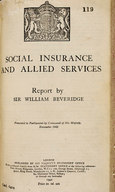
Unternavigation
The Report to Parliament on Social Insurance and Allied Services was published in the United Kingdom in November 1942. Shortly after the Battle of El Alamein – the first major victory of the Allies against the German Wehrmacht – this document constituted an important propaganda tool. Over 600,000 copies were distributed. The author, economist and welfare state expert William Henry Beveridge, had investigated social insurance systems on behalf of the British Government. He outlined a model of social security in which all citizens paid a weekly contribution into a national insurance scheme and, in return, were protected against risks to one’s livelihood such as illness, disability or unemployment. Beveridge argued that it was the duty of the state to stand by its citizens from the cradle to the grave and to combat the five ‘giant evils’: plight, illness, ignorance, squalor and idleness. Beveridge’s proposals for expanding and consolidating social welfare into a comprehensive public insurance system based on a national spread of risk were incorporated into reform programs by the Labour government which took over Churchill’s coalition government in the summer of 1945. The social insurance schemes were expanded and gaps in the welfare system closed in just a short period of time. The National Health Service commenced its work in 1948. These reforms were embedded in extensive planning and nationalization programs.
The welfare model put forward by Beveridge was also met with great interest in Switzerland. However, discourse quickly became dominated by an emphasis on national differences. This was reflected by the Bohren Report of the Federal Social Insurance Office (BSV) published in May 1943 which concluded that the Beveridge plan was neither compatible with Switzerland's federalist state system, nor with the involvement of non-state stakeholders – not to mention the financial requirements such a plan would entail. Discussion regarding the expansion of social security, which also took place in Switzerland in 1942, thus remained limited to certain fields of social provision, especially the AHV and family protection.
Literatur / Bibliographie / Bibliografia / References: Leimgruber Matthieu, Lengwiler Martin (ed.) (2009), Umbruch an der ‚inneren Front‘. Krieg und Sozialpolitik in der Schweiz 1938–1948, Zürich; Monachon Jean-Jacques (2002), Le plan Beveridge et les débats sur la sécurité sociale en Suisse entre 1942 et 1945, in H.-J. Gilomen, S. Guex, B. Studer (ed.), De l’assistance à l’assurance sociale. Ruptures et continuités du Moyen Age au XXe siècle, 321–329, Zürich.
(12/2014)




